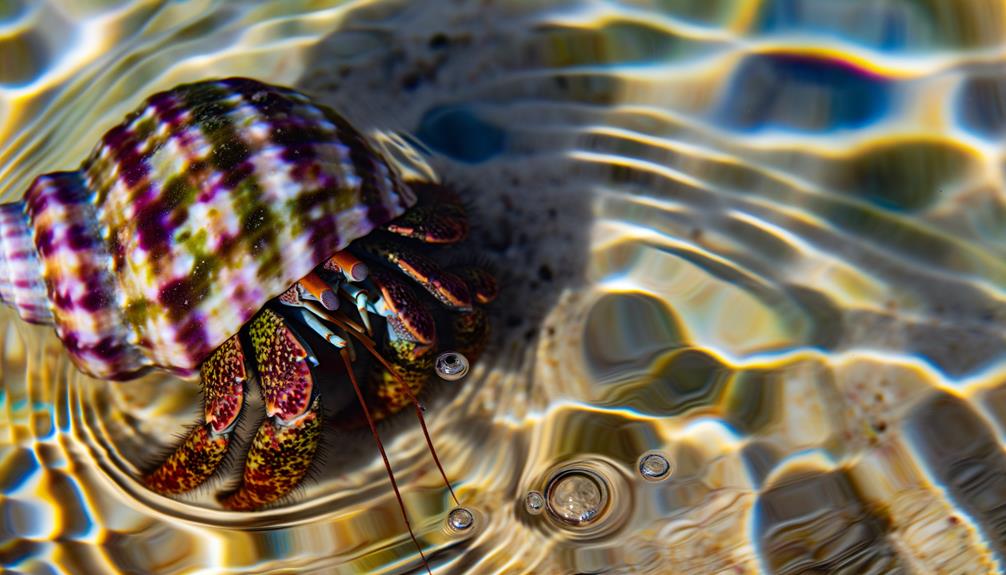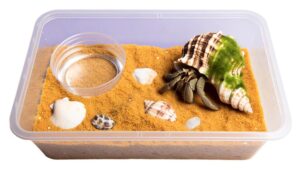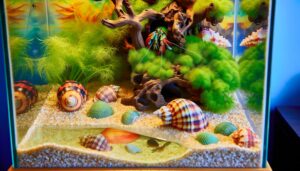Do Hermit Crabs Need Bigger Shells When They Outgrow Their Current Ones?
Hermit crabs need air for survival. They have modified gills that extract oxygen from air, necessitating fresh air supply.
Proper ventilation in their habitat is essential to prevent respiratory distress. Maintaining moisture is also necessary, as it aids in their respiration, molting, and shell health.
Make sure your tank has ideal humidity levels between 70-80%, and monitor temperature consistently at 75-85°F. Noting signs like lethargy or discolored gills can help you address respiratory issues promptly.
Proper tank maintenance, including regular cleaning and air circulation, is crucial for your hermit crab's well-being. There's more to explore on their care and habitat management.

Key Takeaways
- Hermit crabs require air for respiration and to maintain optimal health.
- Proper tank ventilation is essential to ensure adequate air circulation.
- Humidity control is crucial to keep their gills moist for efficient gas exchange.
- Overcrowding in the tank can lead to poor air quality and respiratory issues.
- Regular monitoring of air and humidity levels helps prevent respiratory distress.
Hermit Crab Anatomy
A detailed examination of hermit crab anatomy reveals specialized structures that are necessary for their survival and adaptation. You'll find that their exoskeleton provides not only protection but also structural support.
Within this exoskeleton, hermit crabs possess jointed appendages that facilitate mobility and dexterity, essential for scavenging and defense. Their antennae serve as sensory organs, allowing them to detect environmental cues and locate food.
Additionally, the abdomen is soft and coiled, fitting perfectly into their borrowed shells, which offers added protection against predators. The chelae, or claws, play a crucial role in feeding and manipulating objects.
Each of these anatomical features is evidence of the intricate design nature has provided to ensure hermit crabs thrive in their ecological niche.
How Hermit Crabs Breathe
Unlike many land-dwelling creatures, hermit crabs depend on gills adapted for extracting oxygen from both air and water, ensuring their survival in varied environments. These gills, located within the branchial chambers, function optimally when moist. Consequently, hermit crabs often immerse themselves in water to maintain this necessary moisture level.
When exposed to air, their gills still facilitate gas exchange, although less efficiently than in water. You'll find that hermit crabs possess specialized appendages, known as pleopods, which help circulate water over the gills, enhancing oxygen uptake.
Research indicates that maintaining humidity levels around 70-80% is essential for their respiratory efficiency. By understanding these unique respiratory adaptations, you can create environments that better support their health and well-being, ultimately serving their needs more effectively.
Land Vs. Marine Hermit Crabs
You'll find that land and marine hermit crabs exhibit distinct breathing mechanisms, suited to their respective environments.
Land hermit crabs possess modified gills and require humid air to facilitate gas exchange, while marine hermit crabs rely on fully aquatic gills for underwater respiration.
These adaptations underscore the evolutionary pressures each group faces in their specific habitats.
Breathing Mechanisms Explained
Hermit crabs display distinctive respiratory adaptations, with land hermit crabs relying on modified gills that perform best in humid environments, while marine hermit crabs utilize gills adapted for extracting oxygen from seawater.
You'll find that land hermit crabs possess branchiostegal lungs, which are gills modified to preserve moisture, essential for gas exchange. These specialized structures collapse when too dry, leading to respiratory failure.
Conversely, marine hermit crabs have gills designed to maximize oxygen absorption in aquatic settings. They depend on a continuous flow of water over their gills to extract dissolved oxygen efficiently.
Understanding these mechanisms emphasizes the importance of maintaining ideal environmental conditions to optimize the well-being of both land and marine hermit crabs in captivity.
Habitat Adaptations
Given the distinct respiratory mechanisms of land and marine hermit crabs, their habitat adaptations are meticulously tailored to meet their specific environmental needs.
Land hermit crabs possess modified gills and a branchiostegal lung, allowing efficient air respiration. They thrive in humid environments to prevent desiccation.
Conversely, marine hermit crabs rely on fully aquatic gills, necessitating constant submersion in seawater. You'll find them in tidal zones, where water oxygenation is ideal.
Evidence suggests land hermit crabs must periodically access water to hydrate their gills, while marine counterparts require consistent salinity levels for osmoregulation.
Understanding these habitat-specific adaptations not only informs proper care practices but also highlights the evolutionary intricacies of these fascinating creatures.
Importance of Moisture
You'll find that maintaining sufficient humidity is essential for hermit crabs as it aids in their respiration and keeps their gills moist.
Evidence suggests that proper hydration greatly impacts the molting process, ensuring successful shedding of the exoskeleton.
Additionally, moisture levels directly influence shell health, preventing desiccation and promoting overall well-being.
Humidity and Shell Health
Maintaining ideal humidity levels is essential for promoting the health of a hermit crab's exoskeleton and overall shell integrity. Hermit crabs depend on a humid environment, typically between 70-80%, to facilitate proper respiration through their adapted gills.
Low humidity can result in desiccation, leading to weakened exoskeletons and compromised shell condition. Scientific studies indicate that insufficient moisture levels directly link with increased mortality rates in hermit crabs.
As a caretaker, you must monitor and regulate the habitat's humidity, using hygrometers and misting systems as necessary. Providing a substrate that retains moisture, such as coconut fiber or sand, also supports the optimal hydration of your hermit crab.
Hydration for Molting Process
To support the molting process, your hermit crab requires a consistently moist environment to maintain proper hydration and facilitate successful exoskeleton shedding. Moisture is critical as it prevents dehydration, which can impede the shedding process and cause exoskeletal deformities.
Scientific studies indicate that a relative humidity of 70-80% is ideal. You should provide a shallow dish of dechlorinated water and regularly mist the habitat to maintain these conditions. Additionally, substrate choices like coconut fiber or sand retain moisture effectively, contributing to a stable microenvironment.
Air and Humidity Levels
Maintaining proper air and humidity levels is vital for hermit crabs because they depend on a specific range to support their respiratory and physiological functions. Hermit crabs possess modified gills that need both air and moisture to function efficiently. Keeping a humidity level between 70-80% guarantees that their gills stay moist, enabling effective oxygen absorption.
| Parameter | Ideal Range |
|---|---|
| Humidity | 70-80% |
| Temperature | 75-85°F (24-29°C) |
| Air Circulation | Moderate |
You'll also want to monitor the temperature, maintaining it between 75-85°F. Proper air circulation is essential to prevent mold and bacteria, which can compromise their health. By carefully managing these conditions, you optimize your hermit crabs' well-being and longevity.
Creating the Right Habitat
Crafting an ideal habitat for hermit crabs involves meticulously balancing environmental factors like substrate choice, enclosure size, and the inclusion of climbing structures to simulate their natural surroundings. You need to make sure the habitat mimics their coastal environment to promote their well-being.
- Substrate: Utilize a mix of sand and coconut fiber to maintain humidity and allow for burrowing.
- Enclosure Size: Provide a tank that allows at least 10 gallons per crab to make sure there's ample space for movement and growth.
- Climbing Structures: Include driftwood, rocks, and artificial plants to offer climbing opportunities and mental stimulation.
Common Respiratory Issues
While creating an ideal habitat is pivotal, understanding and addressing common respiratory issues in hermit crabs is equally vital for their overall health. Hermit crabs rely on gills for respiration, which means maintaining prime humidity levels (70-80%) is essential.
Low humidity can cause gill dehydration, leading to respiratory distress. Additionally, mold and fungal growth in their environment can introduce pathogens, resulting in respiratory infections. Ensure regular cleaning and proper ventilation to mitigate these risks.
Ammonia buildup from waste can also irritate gills, so frequent substrate changes are necessary. By staying vigilant and proactive, you'll help create a safe and healthy environment where hermit crabs can thrive.
Addressing these issues guarantees they can breathe comfortably and live longer, healthier lives.
Signs of Respiratory Distress
Observing the early signs of respiratory distress in hermit crabs is essential for timely intervention and treatment. By monitoring their behavior and physical condition, you can identify issues before they escalate.
Key indicators include:
- Lethargy and Reduced Activity: Hermit crabs may become inactive and less responsive to stimuli. This can signify inadequate oxygen intake.
- Discolored Gills: Healthy gills are typically dark or bright red. Pale or discolored gills indicate a lack of oxygen, potentially due to poor ventilation or water quality.
- Excessive Shell Abandonment: Frequently leaving their shells can be a stress response to respiratory distress, as they seek better air quality.
Recognizing these signs allows you to provide effective care and improve their habitat conditions promptly.
Preventing Respiratory Problems
Maintaining optimal habitat conditions for hermit crabs can greatly reduce the risk of respiratory problems.
You'll need to sustain ideal humidity levels, ideally between 70-80%, to prevent gill desiccation. Use a hygrometer to monitor these levels accurately.
Provide a saltwater and freshwater source, as hermit crabs often submerge to keep their gills moist.
Temperature is equally essential; sustain it between 75-85°F using a regulated heater.
Additionally, avoid overcrowding the tank, as this can lead to increased ammonia levels from waste, which irritate their respiratory systems.
Regularly clean the substrate and remove uneaten food to minimize bacterial growth.
Proper Tank Ventilation
Proper tank ventilation is necessary for maintaining a healthy environment for hermit crabs, as it secures the continuous flow of fresh air and prevents the buildup of harmful gases like ammonia. To optimize ventilation, consider these key aspects:
- Ventilation Slots: Guarantee your tank has multiple slots or mesh areas to facilitate air exchange. This prevents stagnant air, promoting respiratory health.
- Humidity Control: Maintain humidity levels between 70-80%. Proper ventilation helps regulate moisture, important for hermit crabs' gill function.
- Air Circulation Devices: Use small fans or air pumps to enhance airflow. These devices can reduce the risk of mold and bacterial growth.
Adopting these measures secures a well-ventilated environment, supporting your hermit crabs' overall well-being.
Monitoring Environmental Conditions
To uphold best health for your hermit crabs, it's important to regularly monitor environmental conditions such as temperature, humidity, and air quality. Hermit crabs thrive in temperatures between 75-85°F and humidity levels around 70-80%. Use a hygrometer and thermometer for precise measurements.
Inadequate humidity can lead to respiratory issues, while improper temperature affects metabolism. Guarantee air quality by maintaining proper tank ventilation; poor air circulation increases the risk of mold and bacterial growth. Regularly clean and replace substrate to prevent ammonia build-up, which can harm your crabs.
Consistent monitoring allows you to make immediate adjustments, ensuring a stable and healthy habitat for your hermit crabs. Accurate data collection methods are critical for their well-being.
Expert Care Tips
To guarantee peak health for your hermit crabs, you should focus on proper tank ventilation to maintain adequate air exchange.
Evidence indicates that controlling humidity levels between 70-80% is vital for their respiratory function.
Additionally, you must practice safe handling techniques to prevent stress and potential harm.
Proper Tank Ventilation
Guaranteeing sufficient tank ventilation is essential for hermit crabs because it helps maintain ideal humidity and oxygen levels necessary for their respiratory health. Proper ventilation prevents the buildup of harmful gases and supports the delicate balance of moisture and air quality.
Here are three expert tips to optimize ventilation:
- Utilize a mesh lid: A mesh lid allows for efficient airflow while keeping the humidity at appropriate levels.
- Install an air pump: An air pump can circulate air within the tank, reducing the risk of stagnant conditions and enhancing oxygen availability.
- Create cross ventilation: Place vents on opposite sides of the tank to promote continuous air exchange, thereby maintaining a healthy environment for your hermit crabs.
Humidity Control Essentials
Maintaining appropriate moisture levels is vital for hermit crabs, as it directly affects their ability to breathe and molt successfully. Aim for a moisture range between 70% and 80%.
Too low, and your hermit crab can suffer from dehydration, affecting its gill function. Too high, and you risk fungal growth and respiratory issues. Use a hygrometer to monitor moisture accurately.
To increase moisture, mist the tank daily and consider using a moisture-retentive substrate like coconut fiber. Additionally, add a shallow dish of water for evaporation. If moisture consistently drops, employ a humidifier.
Safe Handling Practices
When handling hermit crabs, always make certain your hands are clean and free of chemicals, as contaminants can harm their delicate gills. It's important to minimize stress and physical harm during interaction.
Here are three key practices:
- Gentle Grip: Hold the crab by its shell, not its legs or claws, to prevent injury and stress.
- Short Handling Sessions: Limit handling time to a few minutes to reduce exposure to non-ideal environmental conditions.
- Environmental Consistency: Guarantee the surrounding temperature and humidity match their habitat to avoid sudden physiological stress.
These practices are essential for maintaining hermit crab health and well-being. Always prioritize their needs and safety, as improper handling can lead to significant health issues, such as dehydration or shell damage.
Conclusion
Imagine your hermit crab, nestled comfortably in its cozy shell, stretching its delicate gills to sip the moist, oxygen-rich air. By ensuring your tank has proper ventilation and humidity levels, you'll create a thriving environment that mimics their natural habitat.
This attention to detail prevents respiratory issues and promotes vibrant health. Remember, with the right conditions, your hermit crab can flourish, breathing easily and exploring its world with curiosity and vigor.






